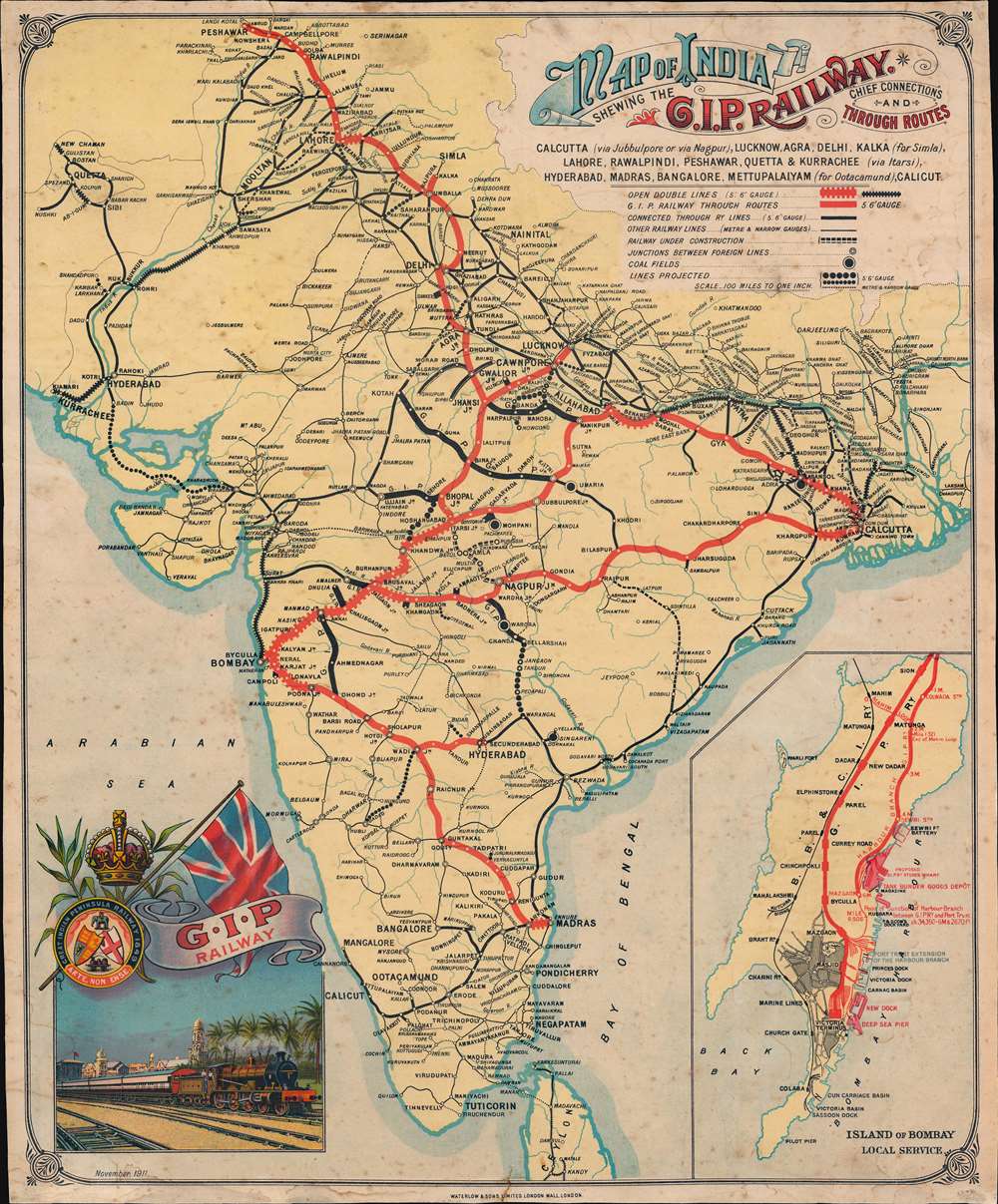This item has been sold, but you can get on the Waitlist to be notified if another example becomes available, or purchase a digital scan.
1911 Waterlow / GIP Railway Map of India w/ Bombay
IndiaGIPRailway-waterlow-1911
Title
1911 (dated) 19.5 x 16.25 in (49.53 x 41.275 cm) 1 : 9000000
Description
Great Indian Peninsular Railway
The GIPR is arguably Asia's busiest and most important railroad network, and certainly Asia's first. Until the second half of the 19th century, development in India was limited to the easily accessible coastlands. Beyond the coast and navigable rivers, lack of infrastructure made accessing and developing the resource-rich interior, particularly the Deccan Plateau, nearly impossible. In 1845, an investment syndicate led by railroad pioneer Robert Stephenson (1803 - 1859) recognized the game-changing potential of a Trans-Subcontinental railroad. Construction began in 1849 under the direction of James John Berkeley (1819 - 1862). The first completed line, from Bombay to Than, opened in 1853. Subsequent new lines and extensions followed as the network grew to encompass the subcontinent.The hoped-for riches were realized, as infrastructure and development exploded throughout the Indian interior. The railroad also brought with it political and economic stability, as it facilitated quick transport of troops, aid, and resources as needed.
The railroad also engendered a rising Indian solidarity movement. The Indian national consciousness, initially hampered by ancient rivalries that far exceeded distaste for the British, emerged as diverse people traveled, communicated, and interacted for the first time. In this context, the railways undermined the 'divide and conquer' strategy that had hitherto defined the British Raj.
When India achieved its long-fought independence in 1951, the GIPR was merged into the Indian Railways. Today, most of the old GIPR lines are still in operation, moving millions of people around the world's most populous country.
The Inspiration of Jules Verne
Three globally significant transportation development occurred in roughly the same year, 1869.- The Suez Canal - An all-important maritime canal linking the Mediterranean and the Indian Ocean.
- The Pacific Railroad - A transcontinental railroad connecting the east and west coast of North America.
- The GPIR's Bombay-Calcutta Line - The first railroad transecting the Subcontinent.
Chromolithography
Chromolithography is a color lithographic technique developed in the mid-19th century. The process involved using multiple lithographic stones, one for each color, to yield a rich composite effect. Oftentimes, the process would start with a black basecoat upon which subsequent colors were layered. Some chromolithographs used 30 or more separate lithographic stones to achieve the desired effect. Chromolithograph color could also be effectively blended for even more dramatic results. The process became extremely popular in the late 19th and early 20th centuries, when it emerged as the dominant method of color printing. The vivid color chromolithography produced made it exceptionally effective for advertising and propaganda imagery.Publication History and Census
This view was printed in London by Waterlow and Son, one of London's largest printers. It was made for display in train stations and billboards in India - a function accounting for its extreme ephemerality, as the tropical climate would have made it unlikely to survive more than a few weeks of service. Indeed, our research suggests this is the only surviving example.Cartographer
Waterlow and Sons (1810 - 1961) was a British engraving and printing concern active in London specializing in currency, postage stamps, bond certificates, and occasionally maps. The firm was founded by James Waterlow (1790 - 1876) in 1810 on Birchin Lane, London, as a legal document printer and copyist. By 1852, they had expanded into stamps and his sons, Albert, Alfred, Sydney, and Walter joined the business. One year after James Waterlow's death, in 1877, infighting among the sons led Alfred Waterlow to split off, forming Waterlow Brothers and Layton. The rift was settled by 1920, and the two firms once again merged under the Waterlow and Sons imprint. They were involved in the Portuguese Bank Note Affair of 1925, wherein the Portuguese fraudster Artur Virgílio Alves Reis convinced the firm to print 200,000 banknotes of 500 Portuguese Escudos each, amounting to roughly 88% of Portugal's GDP. The affair was settled in court with a ruling against Waterlow. In 1928, Waterlow lost its most lucrative contract, printing English banknotes, and began to fall into decline. In 1961, they were acquired by Purnell and Sons who, shortly afterwards, sold the firm to De La Rue. Ironically, De La Rue acquired the contract to print Bank of England banknotes again in 2003 – 75 years after Waterlow lost it! More by this mapmaker...

